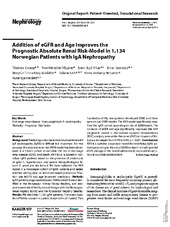| dc.contributor.author | Knoop, Thomas | en_US |
| dc.contributor.author | Vågane, Ann Merethe | en_US |
| dc.contributor.author | Vikse, Bjørn Egil | en_US |
| dc.contributor.author | Svarstad, Einar | en_US |
| dc.contributor.author | Magnusdottir, Bergrun Tinna | en_US |
| dc.contributor.author | Leh, Sabine Maria | en_US |
| dc.contributor.author | Reisæter, Anna Varberg | en_US |
| dc.contributor.author | Bjørneklett, Rune | en_US |
| dc.date.accessioned | 2016-01-29T08:25:53Z | |
| dc.date.available | 2016-01-29T08:25:53Z | |
| dc.date.issued | 2015-05 | |
| dc.Published | American Journal of Nephrology 2015, 41(3):210-219 | eng |
| dc.identifier.issn | 1421-9670 | |
| dc.identifier.uri | https://hdl.handle.net/1956/11021 | |
| dc.description.abstract | Background: Predicting outcome in individual patients with IgA nephropathy (IgAN) is difficult but important. For this purpose, the absolute renal risk (ARR) model has been developed in a French cohort to calculate the risk of end-stage renal disease (ESRD) and death. ARR (0-3) is scored in individual IgAN patients based on the presence of proteinuria ≥1 g/24 h, hypertension, and severe histopathological lesions (1 point per risk factor). We have validated the ARR model in a Norwegian cohort of IgAN patients and tested whether adding data on initial estimated glomerular filtration rate (eGFR) and age improved prediction. Methods: IgAN patients diagnosed between 1988 and 2012 were identified in the Norwegian Kidney Biopsy Registry, and endpoints were identified by record linkage with the Norwegian Renal Registry (ESRD) and the Population Registry (deaths). Results: We identified 1,134 IgAN patients. The mean duration of follow-up was 10.2 years (range 0.0 to 25.7 years). Two hundred and fifty one patients developed ESRD and there were 69 pre-ESRD deaths. The ARR model significantly stratified the IgAN cohort according to risk of ESRD/death. The inclusion of eGFR and age significantly improved the ARR prognostic model; in the receiver operator characteristics (ROC) analysis, area under the curve (AUC) at 10-years of follow-up increased from 0.79 to 0.89, p < 0.001. Conclusions: ARR is a suitable prognostic model for stratifying IgAN patients according to the risk of ESRD or death. Including initial eGFR and age in the model substantially improved its accuracy in our nationwide cohort. | en_US |
| dc.language.iso | eng | eng |
| dc.publisher | Karger | eng |
| dc.rights | Attribution CC BY-NC | eng |
| dc.rights.uri | http://creativecommons.org/licenses/by-nc/3.0/ | eng |
| dc.subject | End-stage renal disease | eng |
| dc.subject | Immunoglobulin A nephropathy | eng |
| dc.subject | Mortality | eng |
| dc.subject | Prognosis | eng |
| dc.subject | Risk factor | eng |
| dc.title | Addition of eGFR and age improves the prognostic absolute renal risk-model in 1,134 norwegian patients with IgA nephropathy | en_US |
| dc.type | Peer reviewed | |
| dc.type | Journal article | |
| dc.date.updated | 2015-12-21T20:11:30Z | |
| dc.description.version | publishedVersion | en_US |
| dc.rights.holder | Copyright 2015 S. Karger AG, Basel | |
| dc.identifier.doi | https://doi.org/10.1159/000381403 | |
| dc.identifier.cristin | 1254303 | |
| dc.subject.nsi | VDP::Medisinske fag: 700::Klinisk medisinske fag: 750::Nefrologi, urologi: 772 | |
| dc.subject.nsi | VDP::Midical sciences: 700::Clinical medical sciences: 750::Nephrology, urology: 772 | |

